2020 Wildlife Sightings: Incredible Findings and Photos
Welcome to the Kiawah Island Nature Program’s 2020 wildlife sightings page. Here you’ll find postings from our Naturalists and island biologists, showing you what is currently in the field, as well as an archive of observations from throughout the year. We hope this site will get you excited about the amazing and diverse wildlife found on Kiawah. Share your photos and stories with us at Kiawah_Recreation@KiawahResort.com.
December 25, 2020 ~ Tagged Bobcat Sighting
 Thank you to Bryce and Wesley Speckman for sharing this bobcat sighting near the East Beach area on Christmas Day!
Thank you to Bryce and Wesley Speckman for sharing this bobcat sighting near the East Beach area on Christmas Day!
We have confirmed with Town Biologists that this is bobcat 450; an adult female that was originally captured and collared in April of 2008, making her at least 12 years old! She was most recently captured and collared in October on Captain Sam’s Spit near the bird banding station.
November 14, 2020 ~ Green Finger Sponge
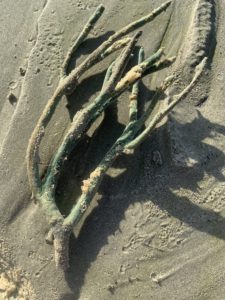 While walking the beach here at Kiawah it isn’t uncommon to find sponges washed up. We usually happen upon them when they’re already dead-aka brown-so it was exciting to find a green finger sponge (Iotrochota birotulata) while beachcombing this week! Before this sponge washed up, it would have been growing in the Caribbean on the sandy hard bottom. (Thanks tropical storm Eta!) The green finger sponge, like other sponges, is a simple multi-celled animal that doesn’t have muscles, nerves, or internal organs. What’s cool about this is that even though they don’t seem to have much going on, they can filter an amount of water 100,000 times their size every day! Did you know…if you broke a sponge down to its cellular level, the cells would be able to recognize each other’s unique function and reform into small new sponges!
While walking the beach here at Kiawah it isn’t uncommon to find sponges washed up. We usually happen upon them when they’re already dead-aka brown-so it was exciting to find a green finger sponge (Iotrochota birotulata) while beachcombing this week! Before this sponge washed up, it would have been growing in the Caribbean on the sandy hard bottom. (Thanks tropical storm Eta!) The green finger sponge, like other sponges, is a simple multi-celled animal that doesn’t have muscles, nerves, or internal organs. What’s cool about this is that even though they don’t seem to have much going on, they can filter an amount of water 100,000 times their size every day! Did you know…if you broke a sponge down to its cellular level, the cells would be able to recognize each other’s unique function and reform into small new sponges!
~ Naturalist, Samantha
November 12, 2020 ~ Pelagic Goose Barnacles
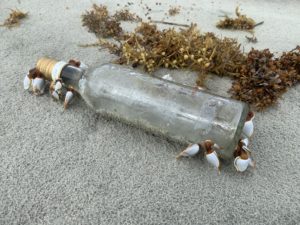 Tropical Storm Eta has been churning up the water off of our Kiawah beach this week and causing some interesting things to wash up. We like to make it a point to throw away or recycle things found on the beach that don’t belong there but this particular bottle had some pelagic goose barnacles (Lepas anatifera) living on it! This species can be found on objects floating in the open ocean all over the world but more commonly in tropical and subtropical areas. Barnacles are crustaceans that are related to crabs, lobsters, and shrimps (it sounds weird but yes, it really is the proper plural form of shrimp). The barnacles attached to this bottle by secreting their own fast-drying cement. Their cement is so strong that researchers are trying to figure out how it could be used commercially! While the pelagic goose barnacles drift along in the open ocean, they open up and have feather-like appendages called ciri come out and collect microscopic organisms for them to eat. We poked at our barnacles to see if they were alive and sure enough, they retracted at our touch! In order to keep them alive, the bottle was thrown back into the ocean along with a wish that Eta will have plenty of microorganisms mixed up out there for them to feast on!
Tropical Storm Eta has been churning up the water off of our Kiawah beach this week and causing some interesting things to wash up. We like to make it a point to throw away or recycle things found on the beach that don’t belong there but this particular bottle had some pelagic goose barnacles (Lepas anatifera) living on it! This species can be found on objects floating in the open ocean all over the world but more commonly in tropical and subtropical areas. Barnacles are crustaceans that are related to crabs, lobsters, and shrimps (it sounds weird but yes, it really is the proper plural form of shrimp). The barnacles attached to this bottle by secreting their own fast-drying cement. Their cement is so strong that researchers are trying to figure out how it could be used commercially! While the pelagic goose barnacles drift along in the open ocean, they open up and have feather-like appendages called ciri come out and collect microscopic organisms for them to eat. We poked at our barnacles to see if they were alive and sure enough, they retracted at our touch! In order to keep them alive, the bottle was thrown back into the ocean along with a wish that Eta will have plenty of microorganisms mixed up out there for them to feast on!
~ Naturalist, Samantha
November 11, 2020 ~ Sargassum (or, SargassYum, amirite?)
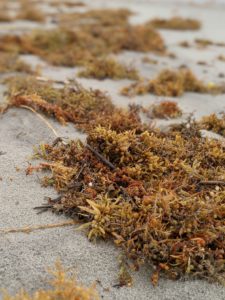 Head out to the beach right now and you’ll see the sands strewn as far as you can see with mats of a yellowish seaweed. This is Sargassum (genus Sargassum), a brown algae full of tiny little air bladders which allow it to float at the ocean’s surface soaking in sunlight. Just past the Gulf Stream, out into the calmer waters of the North Atlantic Gyre is a massive area known as the Great Sargasso Sea where miles and miles of this floating algae collect providing food and shelter for animals ranging from crabs and jellies to fish and even sea turtles! In fact, research has shown that baby Loggerhead Sea Turtles often head out into the Sargasso Sea after they hatch to spend the next few decades of their life (a period of time sometimes known as the “lost years” because we used to have no idea where they went!) floating among the sargassum, staying warm in the sun, and getting fat and happy until they’re old enough to start breeding and head back to their home beaches.
Head out to the beach right now and you’ll see the sands strewn as far as you can see with mats of a yellowish seaweed. This is Sargassum (genus Sargassum), a brown algae full of tiny little air bladders which allow it to float at the ocean’s surface soaking in sunlight. Just past the Gulf Stream, out into the calmer waters of the North Atlantic Gyre is a massive area known as the Great Sargasso Sea where miles and miles of this floating algae collect providing food and shelter for animals ranging from crabs and jellies to fish and even sea turtles! In fact, research has shown that baby Loggerhead Sea Turtles often head out into the Sargasso Sea after they hatch to spend the next few decades of their life (a period of time sometimes known as the “lost years” because we used to have no idea where they went!) floating among the sargassum, staying warm in the sun, and getting fat and happy until they’re old enough to start breeding and head back to their home beaches.
If you’re walking on the beach, get a closer look at the sargassum, admire its air bladders, and see if you can spot anything else interesting among the mass of weeds!
~ Naturalist, Peter
October 22nd, 2020 ~ Manatee Sighting in the Kiawah River
I was down at Mingo Point around 8:30 am when I heard a dolphin come up for air, or, what I thought was a dolphin. I turned to get my eyes on it, but instead of a dolphin, I saw a manatee only about 30ft. from me! The manatee, with it’s big ‘ol paddle-like tail, was maybe around 8 feet long and moving freely down river. I tried to make out if it had any unique markings or was suffering from any entanglement- from what I could tell it lacked both. I then informed Lauren Rust, executive director of Lowcountry Marine Mammal Network, and also reported the sighting to SCDNR. Manatees migrate to South Carolina’s coastal ecosystems as the water temperatures rise each year. Although it is somewhat unusual to see one still here in October, Lauren Rust comments, “The water temp is still pretty warm, so it’s not an issue.” Resources state that once water temperatures fall below around 70°F, manatees begin to move back to warmer waters around Florida. According to Captain Mike water temp was 74° around Mingo Point during the time it was sighted.
~ Naturalist, AK
October 22nd, 2020 ~ Two- Striped Walking Sticks
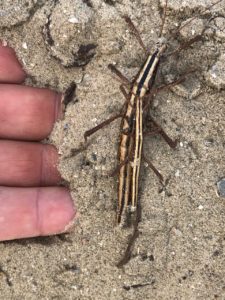 While out walking near the Ocean Course on a birding tour, Naturalist Peter and a guest spotted this strange insect-shaped stick with way too many legs sitting on the sand which, upon closer inspection, proved to be not just one, but two insects! They were Two-striped Walking Sticks (genus Anisomorpha), a type of stick insect found in our area feasting on leaves of shrubs or walking along the ground. The smaller individual on the back of the larger one is the male which often hitch rides on the larger females waiting for their chance to mate. Be sure to keep your eyes on the ground wherever you are because you never know what may be more than it appears!
While out walking near the Ocean Course on a birding tour, Naturalist Peter and a guest spotted this strange insect-shaped stick with way too many legs sitting on the sand which, upon closer inspection, proved to be not just one, but two insects! They were Two-striped Walking Sticks (genus Anisomorpha), a type of stick insect found in our area feasting on leaves of shrubs or walking along the ground. The smaller individual on the back of the larger one is the male which often hitch rides on the larger females waiting for their chance to mate. Be sure to keep your eyes on the ground wherever you are because you never know what may be more than it appears!
~ Naturalist, Peter
October 21st, 2020 ~ Rosy Wolfsnail
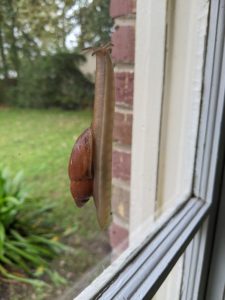 We like to talk a lot about the whelks, moon snails, and other sea snails you find around the beaches and salt marshes of Kiawah Island, but that doesn’t mean we don’t have our fair share of land snails, too! Naturalist Peter found this long, slimy snail slowly sliding up a window showing off its gorgeous shell and the waves of muscle contractions that help move them along. This is a Rosy Wolfsnail (Euglandina rosea) sometimes known by its more sinister name, the cannibal snail. They are a carnivorous land snail which spend their days hunting and gorging themselves on other snails and slugs. While they’re native to our area, they have become wide-spread and invasive in many forests around the world. They were introduced to Hawaii in 1955 with the hope that they would eat another invasive snail, but that plan backfired and they are now considered responsible for the extinction of several species of native Hawaiian snail. These fellows are good reminder that a helpful native species in one area can cause a lot of problems when we try to mess around with the natural balance of nature.
We like to talk a lot about the whelks, moon snails, and other sea snails you find around the beaches and salt marshes of Kiawah Island, but that doesn’t mean we don’t have our fair share of land snails, too! Naturalist Peter found this long, slimy snail slowly sliding up a window showing off its gorgeous shell and the waves of muscle contractions that help move them along. This is a Rosy Wolfsnail (Euglandina rosea) sometimes known by its more sinister name, the cannibal snail. They are a carnivorous land snail which spend their days hunting and gorging themselves on other snails and slugs. While they’re native to our area, they have become wide-spread and invasive in many forests around the world. They were introduced to Hawaii in 1955 with the hope that they would eat another invasive snail, but that plan backfired and they are now considered responsible for the extinction of several species of native Hawaiian snail. These fellows are good reminder that a helpful native species in one area can cause a lot of problems when we try to mess around with the natural balance of nature.
~Naturalist, Peter
October 17th, 2020 ~ Knobbed Whelk
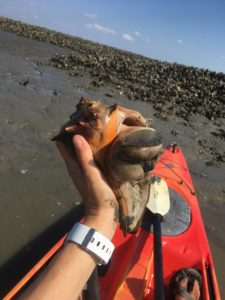 Check out this live Knobbed Whelk (Busycon carica) spotted by guests during a Marsh Kayak trip! This marine snail species is a carnivore that will feed on bivalves found on the water floor. The gorgeous Whelk in the photo is more than likely a female, as she is larger than Naturalist, Meredith’s hand. If you look closely, you can see her hard operculum, that acts almost as a door, closing her up into her shell, on top of her large foot!
Check out this live Knobbed Whelk (Busycon carica) spotted by guests during a Marsh Kayak trip! This marine snail species is a carnivore that will feed on bivalves found on the water floor. The gorgeous Whelk in the photo is more than likely a female, as she is larger than Naturalist, Meredith’s hand. If you look closely, you can see her hard operculum, that acts almost as a door, closing her up into her shell, on top of her large foot!
~ Naturalist, Meredith
October 17th, 2020 ~ Rough Green Snake
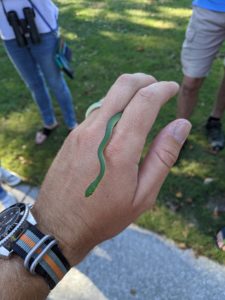 While out on a Gator Walk, a young guest spotted this tiny green snake sunning itself on the edge of a road in Turtle Beach. While, in my humble opinion, all snakes are pretty, this fellow was especially pretty with adorable eyes and emerald green scales. This was a young Rough Green Snake (Opheodrys aestivus). They use their green color to blend in with leaves and vines as they take to the trees and shrubs to hunt for tasty insects and other vertebrates. Their name comes from their keeled scales, each of which has a tiny bump running the length of it like the keel of a boat, that gives them a slightly rough texture. We tried to convince this guy that the side of a road wasn’t the best place to bask, and he eventually made his way back into the shrubs along the edge of the pond.
While out on a Gator Walk, a young guest spotted this tiny green snake sunning itself on the edge of a road in Turtle Beach. While, in my humble opinion, all snakes are pretty, this fellow was especially pretty with adorable eyes and emerald green scales. This was a young Rough Green Snake (Opheodrys aestivus). They use their green color to blend in with leaves and vines as they take to the trees and shrubs to hunt for tasty insects and other vertebrates. Their name comes from their keeled scales, each of which has a tiny bump running the length of it like the keel of a boat, that gives them a slightly rough texture. We tried to convince this guy that the side of a road wasn’t the best place to bask, and he eventually made his way back into the shrubs along the edge of the pond.
~ Naturalist, Peter
October 16th, 2020 ~ American Avocet
 Spoonbills may be top of the pack with their unique, well, spoon-shaped beaks, but a close runner-up in the Neat Beak category is the American Avocet (Recurvirostra americana) like this handsome fellow spotted recently near the Ocean Course on a Back Island Birding Adventure. In summer, they look extra elegant with a rusty neck and head contrasting nicely with their black and white wings, but they are still plenty fancy even in winter when they lose their color. The main attraction is the thin, recurved beak that gives them their scientific name which they use to delicately forage for aquatic insects and crustaceans. In wintertime, they are more likely to be spotted foraging on tidal flats and mud banks, so keep your eyes out for avocets as the weather gets cooler!
Spoonbills may be top of the pack with their unique, well, spoon-shaped beaks, but a close runner-up in the Neat Beak category is the American Avocet (Recurvirostra americana) like this handsome fellow spotted recently near the Ocean Course on a Back Island Birding Adventure. In summer, they look extra elegant with a rusty neck and head contrasting nicely with their black and white wings, but they are still plenty fancy even in winter when they lose their color. The main attraction is the thin, recurved beak that gives them their scientific name which they use to delicately forage for aquatic insects and crustaceans. In wintertime, they are more likely to be spotted foraging on tidal flats and mud banks, so keep your eyes out for avocets as the weather gets cooler!
~ Naturalist, Peter, Photo by Aimee Taylor
October 8th, 2020 ~ Mantis Shrimp
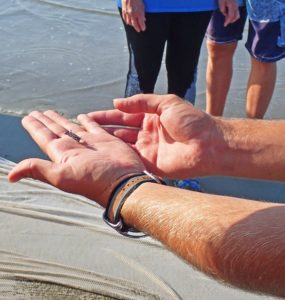 While pulling a seine net through the surf near the Ocean Course recently, a few of our naturalists found this curious crustacean mixed in with the silversides and other little fishes. This little fellow is a species of mantis shrimp called Coronis excavatrix. What’s a mantis shrimp, you ask? They’re not really mantises nor are they closely related to any shrimp you may be thinking of. Mantis shrimp, aka Stomatopods, are a really unique group crustaceans found throughout the world with some pretty superhero-like abilities. Some are known to punch their prey with the speed and power rivaling a bullet and see colors far outside of the measly spectrum of visual light we see. But for the most part, the mantis shrimp we find around here are fairly content to hide in small burrows and live their tiny lives. Remember, even if you can’t see them, the beaches and salt marshes around Kiawah Island are full of some pretty spectacular critters.
While pulling a seine net through the surf near the Ocean Course recently, a few of our naturalists found this curious crustacean mixed in with the silversides and other little fishes. This little fellow is a species of mantis shrimp called Coronis excavatrix. What’s a mantis shrimp, you ask? They’re not really mantises nor are they closely related to any shrimp you may be thinking of. Mantis shrimp, aka Stomatopods, are a really unique group crustaceans found throughout the world with some pretty superhero-like abilities. Some are known to punch their prey with the speed and power rivaling a bullet and see colors far outside of the measly spectrum of visual light we see. But for the most part, the mantis shrimp we find around here are fairly content to hide in small burrows and live their tiny lives. Remember, even if you can’t see them, the beaches and salt marshes around Kiawah Island are full of some pretty spectacular critters.
~ Naturalist, Peter
August 10th, 2020 ~ Moon Snail
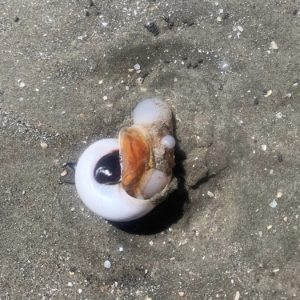
What the heck is that? This strange specimen is a shark eye, or moon snail. Shark eye snails (Neverita duplicata) live just below the surface of the sand and prey on other critters living in the sand. Ever wonder how the shells you find on the beach with the perfect holes in them happened to get those holes? Well those shells used to belong to clams (and sometimes other shark eye snails-gasp!). The shark eye snails use their spiny tongue to drill a hole into the shell of one side of the clams, spit acid inside, liquefying the clam, and then drink it up. What’s left is two shells, one with a hole and one without. Next time you use these shells to string together a pretty necklace, remember to thank your friend the shark eye snail!
~Naturalist, Samantha
April 8th, 2020 ~ Golden Silk Orbweaver
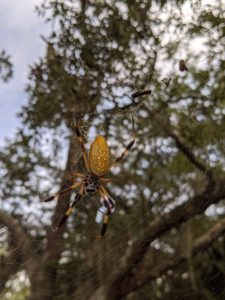
She may be one of the largest, leggiest spiders on Kiawah, but she’s nothing to worry about! If you’ve been biking around the island in summer, you may have seen some very large webs stretched from tree to tree with a massive, spindly-legged spider sitting right in the middle. These are Golden Silk Orb-weavers (Nephila clavipes). They’re sometimes called “banana spiders” due to their banana-like (sort of) abdomen, but their fancier name comes from the golden hue of their silk which, if you have a lot of time and spiders on your hands, can be woven into gold-colored fabrics.
Next time you spot one, also look for one or more smaller spiders sharing her web, but usually on the opposite side. The smaller tag-alongs are the male spiders of the same species which remain close to the female but no too close. Female Golden Silk Orb-weavers sometimes decide to eat males that stick around for too long.
-Naturalist, Peter
April 2nd, 2020 ~ Bird Checklist
April 1st, 2020 ~ Bubblegum Lichen
 Lichen is a combination of two things performing a symbiotic relationship: fungi provides the “home”, while the algae provides the “food” through photosynthesis. Pictured is a species of lichen commonly known as “Christmas Wreath Lichen” or “Bubblegum Lichen” (Cryptothecia rubrocincta). C rubrocincta is found throughout the southeastern US, and even some parts of South America. In Brazil, its red/pink pigment is sometimes used as a source of dye.
Lichen is a combination of two things performing a symbiotic relationship: fungi provides the “home”, while the algae provides the “food” through photosynthesis. Pictured is a species of lichen commonly known as “Christmas Wreath Lichen” or “Bubblegum Lichen” (Cryptothecia rubrocincta). C rubrocincta is found throughout the southeastern US, and even some parts of South America. In Brazil, its red/pink pigment is sometimes used as a source of dye.
On Kiawah Island however, it is often found thriving on some of our Southern Live Oaks (Quercus virginiana). This particular example is located near one of our marsh towers on Governor’s Drive, right off the bike path where one of our Naturalists stopped her tour group to snap a quick photo!
March 29th, 2020 ~ New Neighbor!
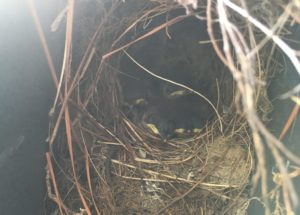 Naturalist Meredith recently had a new neighbor move in right next to her front door! Early this spring, a Carolina Wren pair began constructing their nest inside of her mailbox. Luckily, the post office employees have been very understanding! It is not uncommon for Carolina Wrens to build their nests in seemingly inconvenient places. They just need an open cavity between 3 and 6 feet above the ground. This means that mailboxes, flower pots, propane-tank covers, old boots, overhangs, and stumps are all fair game!
Naturalist Meredith recently had a new neighbor move in right next to her front door! Early this spring, a Carolina Wren pair began constructing their nest inside of her mailbox. Luckily, the post office employees have been very understanding! It is not uncommon for Carolina Wrens to build their nests in seemingly inconvenient places. They just need an open cavity between 3 and 6 feet above the ground. This means that mailboxes, flower pots, propane-tank covers, old boots, overhangs, and stumps are all fair game!
The male and female pair work together to build their nest and will add any kind of material such as pine straw, bark, dried grasses, snake sheds, hair, feathers, straw, even litter like plastics and string to build up their nest. A tell-tale sign of a Carolina Wren nest a side entrance and domed top. Once their nest is ready, the female will lay between 3 and 7 eggs which will hatch after about two weeks! How many babies can you see in this nest? After another two weeks of the excellent care that this mama Carolina Wren will give her young, they will fledge from the nest. As fledglings, they are in a strange, what we call “teenager phase.” They are awkward-looking, not super great at flying yet, and you may find yourself thinking “does that little bird need my help?” The answer is no! Animal parents are AMAZING! They are still watching over and taking care of their young, even if we don’t see them right there! If you happen upon a baby bird on the ground that still has its eyes closed, take a look around and see if there is a nest nearby. Chances are it accidentally fell out and you can gently replace it. If you don’t see a nest, you can put the baby animal in a cardboard box with a towel and warm water bottle and place it into a tree, just to make sure you give mom a chance to come find her baby!
Keep an eye out for birds building nests in your yard or neighborhood and listen for the call of those hungry baby birds!
March 26th, 2020~ Polyphemus Moth Antheraea polyphemus
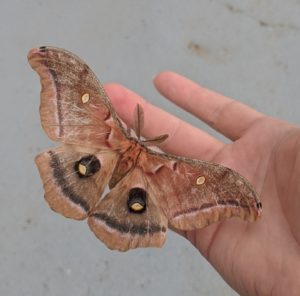 Keep your eyes peeled at all times because you never know when you may come face-to-face with a creature from mythology! Well, sort of. This massive fellow is a Polyphemus Moth named after the cyclops, Polyphemus, in Greek mythology. Except this moth has two eye spots while a cyclops has just one… that’s kind of their whole thing. Sometimes naming animals is hard.
Keep your eyes peeled at all times because you never know when you may come face-to-face with a creature from mythology! Well, sort of. This massive fellow is a Polyphemus Moth named after the cyclops, Polyphemus, in Greek mythology. Except this moth has two eye spots while a cyclops has just one… that’s kind of their whole thing. Sometimes naming animals is hard.
Polyphemus moths are large silk moths which can have wingspans up to 6 inches across. The caterpillars of this species are green and chunky, and can eat over 80,000 times their own bodyweight, while the large adults don’t feed at all! Polyphemus moths are widespread across North America and are truly a sight to see, especially when you can get a close look at their gorgeous antennae and deep-purple eye spots.
-Naturalist, Peter Bergeson
March 26th, 2020 ~ Knobbed Welk
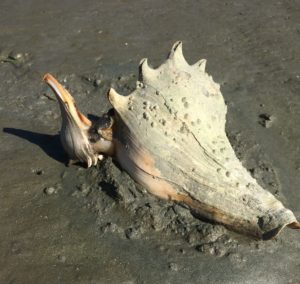 The birds and the bees and… the Knobbed Whelks? That’s right! During a low tide cycle in the Kiawah River, our group of Naturalists came across an interesting sight on an exposed sandbar: two Knobbed Whelks (Busycon carica) attached to each other! Whelks are a species of marine snail and there are a few misconceptions surrounding this animal. The first is that many people believe they are conchs. Well, just like the first way to tell the difference between Alligators and Crocodiles in South Carolina is that we don’t have Crocodiles, we also don’t have true Conchs! Conchs are grazing herbivores that grow very large in comparison to most Whelk snails that you may find and so they reside in warm, tropical waters further south where their food sources are plentiful and they can grow large and mighty. Another misconception that we Naturalists often hear is that these are Hermit Crabs. While that can be true to an extent, these shells always start out as a snail. Females lay long strands lined with dozens of rubbery capsules containing up to 100 miniature versions of Knobbed Whelks. As long as the snail is alive and eating, it’s shell will continue to grow! Only once the snail dies or becomes someone else’s snack does its shell become abandoned and hermit crabs can use it as a temporary home. Remember if you find any shells that look like this on the beach or in the marsh, you should always make sure no one is home, but even better try to practice “leave no trace” and admire it, but leave it for the next hermit crab who might be looking for the perfect home!
The birds and the bees and… the Knobbed Whelks? That’s right! During a low tide cycle in the Kiawah River, our group of Naturalists came across an interesting sight on an exposed sandbar: two Knobbed Whelks (Busycon carica) attached to each other! Whelks are a species of marine snail and there are a few misconceptions surrounding this animal. The first is that many people believe they are conchs. Well, just like the first way to tell the difference between Alligators and Crocodiles in South Carolina is that we don’t have Crocodiles, we also don’t have true Conchs! Conchs are grazing herbivores that grow very large in comparison to most Whelk snails that you may find and so they reside in warm, tropical waters further south where their food sources are plentiful and they can grow large and mighty. Another misconception that we Naturalists often hear is that these are Hermit Crabs. While that can be true to an extent, these shells always start out as a snail. Females lay long strands lined with dozens of rubbery capsules containing up to 100 miniature versions of Knobbed Whelks. As long as the snail is alive and eating, it’s shell will continue to grow! Only once the snail dies or becomes someone else’s snack does its shell become abandoned and hermit crabs can use it as a temporary home. Remember if you find any shells that look like this on the beach or in the marsh, you should always make sure no one is home, but even better try to practice “leave no trace” and admire it, but leave it for the next hermit crab who might be looking for the perfect home!
March 24th, 2020~ Mingo Point Birding
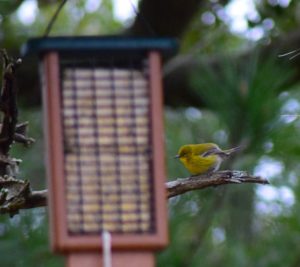 A variety of birds were spotted at Mingo Point today by Naturalist Peter, including one of our favorites, the Pine Warbler. These bright yellow songbirds can be heard all around the pine trees and feed on a variety of bugs, such as caterpillars and beetles, and of course, pine seeds!
A variety of birds were spotted at Mingo Point today by Naturalist Peter, including one of our favorites, the Pine Warbler. These bright yellow songbirds can be heard all around the pine trees and feed on a variety of bugs, such as caterpillars and beetles, and of course, pine seeds!
Read about all the other species of birds Peter saw here.
March 23rd, 2020 ~ Gray Tree Frog
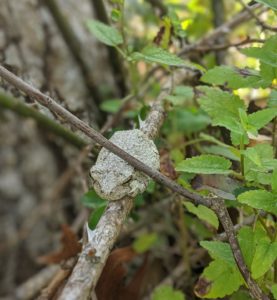 Be sure to keep your eyes peeled whenever you are trimming bushes and trees in your yard as you never know who might be hiding perfectly camouflaged right in plain sight! This very handsome Gray Treefrog found a very cozy place to hide in a rose bush on Johns Island. This is the time of year when you may start finding many different treefrogs climbing on your windows, doors, bushes, and pretty much anywhere else their sticky little fingers can reach. I particularly enjoy watching them climb across my window at night eating the little flies that are attracted by my porch lights. Dinner AND a show! Now, back to this Gray Treefrog. There are actually a couple species of gray treefrog in the area which can be very tricky to tell apart, so I don’t actually know which species this guy actually is. All I know is that he’s a great frog and I’m very happy to have him living in my front yard! Hopefully he’ll serenade me with his lovely trilling call in the evening. I’ll keep my eyes out for you, buddy.
Be sure to keep your eyes peeled whenever you are trimming bushes and trees in your yard as you never know who might be hiding perfectly camouflaged right in plain sight! This very handsome Gray Treefrog found a very cozy place to hide in a rose bush on Johns Island. This is the time of year when you may start finding many different treefrogs climbing on your windows, doors, bushes, and pretty much anywhere else their sticky little fingers can reach. I particularly enjoy watching them climb across my window at night eating the little flies that are attracted by my porch lights. Dinner AND a show! Now, back to this Gray Treefrog. There are actually a couple species of gray treefrog in the area which can be very tricky to tell apart, so I don’t actually know which species this guy actually is. All I know is that he’s a great frog and I’m very happy to have him living in my front yard! Hopefully he’ll serenade me with his lovely trilling call in the evening. I’ll keep my eyes out for you, buddy.
-Naturalist, Peter Bergeson
March 18, 2020 ~ Red Knot’s Take Flight
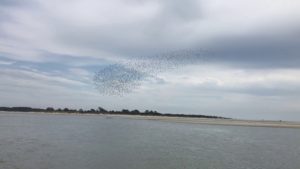 Captain Brad spotted thousands of Red Knots (Calidris canutus rufa) taking flight at Captain Sam’s Inlet. These birds take an incredible journey from South America to the Arctic, traveling over 9,000 miles, sometimes flying for 6-8 days continuously over the open ocean without stopping. They have chosen Kiawah as their critical staging area during migration to rest and feed before continuing to their Arctic breeding grounds.
Captain Brad spotted thousands of Red Knots (Calidris canutus rufa) taking flight at Captain Sam’s Inlet. These birds take an incredible journey from South America to the Arctic, traveling over 9,000 miles, sometimes flying for 6-8 days continuously over the open ocean without stopping. They have chosen Kiawah as their critical staging area during migration to rest and feed before continuing to their Arctic breeding grounds.
March 10th, 2020~ Bright pinks and purples, oh my!
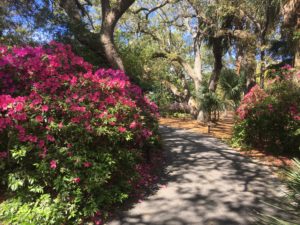 Check out the colors of this Azalea-lined bike path in Night Heron Park! Azaleas are a common plant, encompassing hundreds of different species, whose flowers can range from whites to pinks, purples, oranges, and even reds! They have a wide-spread range along the eastern coast of the United States and while they provide nectar for bees, hummingbirds, and butterflies it is the butterflies that actually do the most for the plant itself! While we normally think of pollinators (like bees) that carry and transfer pollen on their body, in the case of the azalea’s flowers, it is the wings of the butterfly that the pollen sticks to! While they are feasting on nectar, butterflies will continue to flap their wings. This action stirs up pollen and allows it to land on their wings. Because their wings are so long, they are able to easily transfer pollen around the flower, making them the most efficient pollinator of Azaleas!
Check out the colors of this Azalea-lined bike path in Night Heron Park! Azaleas are a common plant, encompassing hundreds of different species, whose flowers can range from whites to pinks, purples, oranges, and even reds! They have a wide-spread range along the eastern coast of the United States and while they provide nectar for bees, hummingbirds, and butterflies it is the butterflies that actually do the most for the plant itself! While we normally think of pollinators (like bees) that carry and transfer pollen on their body, in the case of the azalea’s flowers, it is the wings of the butterfly that the pollen sticks to! While they are feasting on nectar, butterflies will continue to flap their wings. This action stirs up pollen and allows it to land on their wings. Because their wings are so long, they are able to easily transfer pollen around the flower, making them the most efficient pollinator of Azaleas!
-Naturalist, Meredith
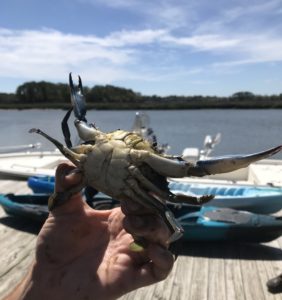 Have you ever looked straight into the eyes of an animal and felt like all it yearns to do in that moment is to pinch your nose off? I sometimes get that feeling around the Atlantic Blue Crab (Callinectes sapidus). These well-known local crabs are absolutely gorgeous and well-deserving of their name, but definitely have an attitude. I guess you can’t blame this one since it was being held by a giant monster many times its own size (me).
Have you ever looked straight into the eyes of an animal and felt like all it yearns to do in that moment is to pinch your nose off? I sometimes get that feeling around the Atlantic Blue Crab (Callinectes sapidus). These well-known local crabs are absolutely gorgeous and well-deserving of their name, but definitely have an attitude. I guess you can’t blame this one since it was being held by a giant monster many times its own size (me).
This particular crab is a male which can easily be seen from this angle. Blue crabs have a reduced abdomen called an “apron” which they keep curled tight underneath their bodies. Male crabs, like this one, have skinny, pointed aprons in the shape of a rocket ship or the Washington Monument. Fully mature females have a wide, rounded apron which looks like the dome of the Capitol building in Washington, D.C. which they use to hold and protect their eggs. In addition to the shape of the apron, a female crab will have bright red-orange tips on her claws. Admire these crabs whenever you see them, but don’t get too close!
-Naturalist, Peter Bergeson
February 18, 2020 ~ Sea Cucumbers Galore!
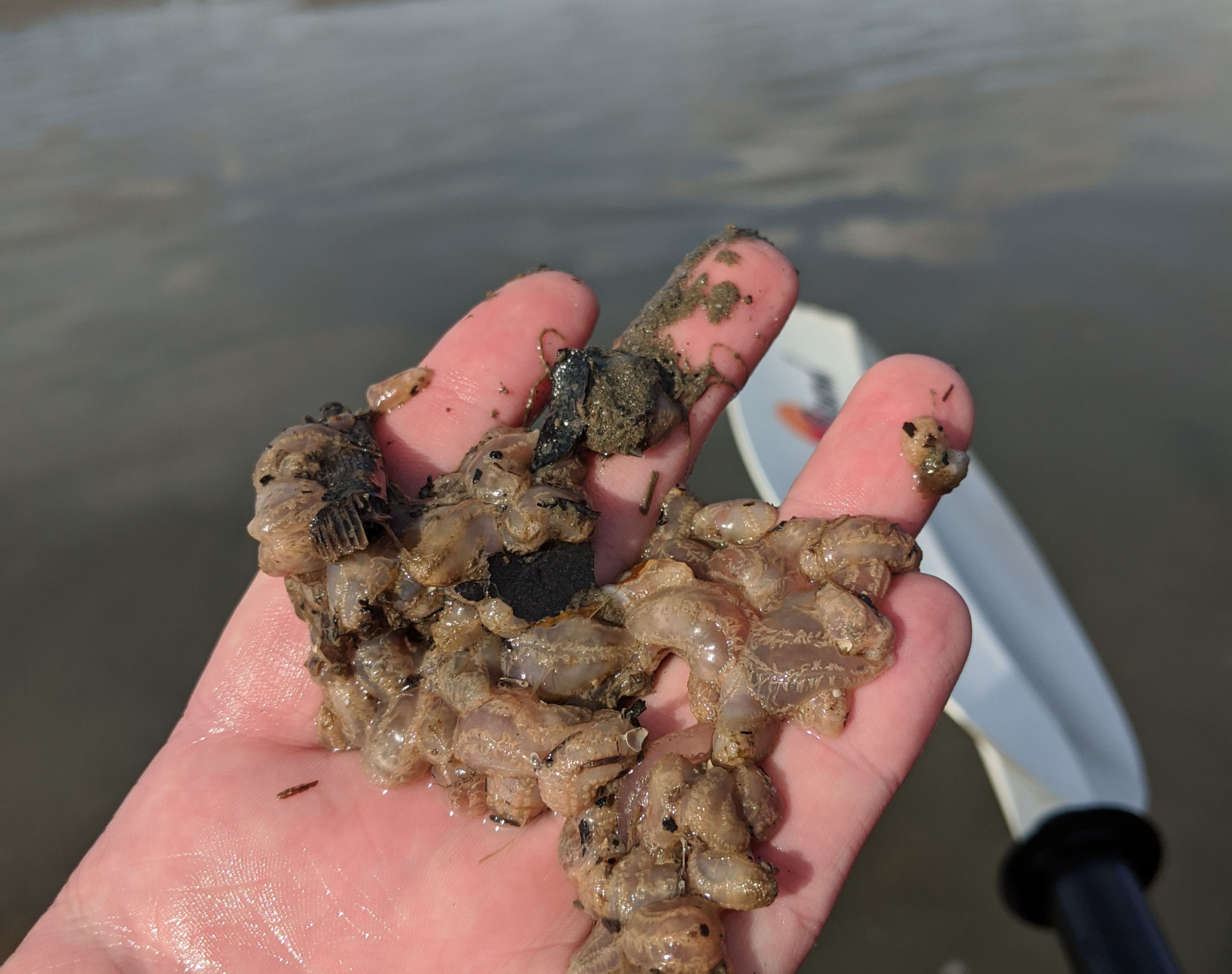
Not all fascinating animal sightings on Kiawah Island are of large, charismatic critters. Last weekend, on a Marsh Kayak trip, the full moon brought us some extreme low tides which exposed huge tracts of mud on the Kiawah River. If you happened to be out navigating these muddy mazes, you may have seen what looked like large patches of gooey…something covering the river floor (and attracting a decent number of Herring Gulls). These were millions of small, pinkish, wormy critters, some up to 2 inches long, and few even had a net of tentacles sticking out of one end which were quickly retracted when touched. These fellows are Pentamera pulcherrima, a common local sea cucumber. What is a sea cucumber, you ask? Sea cukes are actually echinoderms—relatives of sea stars, sand dollars, and sea urchins. While their cousins are disc- or star-shaped and radially symmetrical and have hundreds of tiny tube feet on their bottom half, sea cucumbers are tube-like (bilaterally symmetrical) and have rows of tube feet running the length of their bodies. They are normally found burrowing in the mud where they extend their branched tentacles hoping to catch food particles. They dislodge easily and are commonly found washed up on Lowcountry beaches. Keep your eyes on the sand and mud and who knows what you’ll find!
-Naturalist, Peter Bergeson
February 8, 2020 ~ Mink in the mud
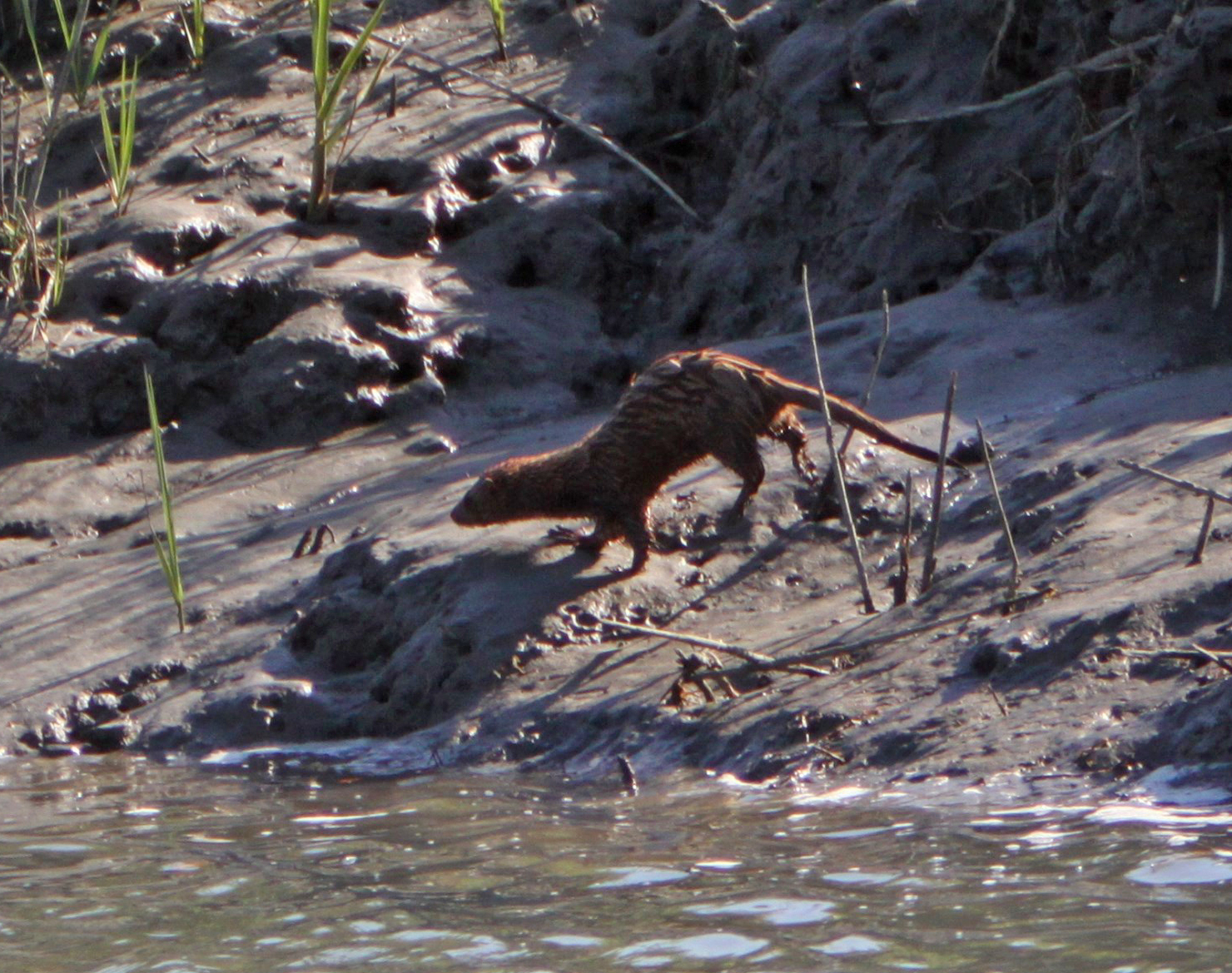
We had a mink sighting at Mingo Point this past Wednesday! American minks like to hang out around our marshes in the Kiawah River. Minks are built for the water; they are good swimmers and can dive up to 16 feet. Their hair is very oily to help make them waterproof, and they even have slightly webbed feet. They dig their den into riverbanks, find a hollow log, or use an abandoned den, but they never use the same den for very long. In case of an intruder, the mink can spray a foul-smelling liquid similar to a skunk, except that the mink cannot aim its spray. These cute critters are best observed from a distance!
-Naturalist, Samantha Hart
February 7, 2020 ~ Bobbing Ducks
If you find yourself wandering the beaches on the east end of Kiawah Island near the Ocean Course, scan your eyes (or binoculars, if you have them) across the surface of the water just past the breakers and you just might see hundreds of little black dots bobbing up and down in the waves.
These dots are Scaups, diving ducks that take a break from their breeding grounds in the Canadian arctic to spend the winters off the coast! More specifically, they’re likely Lesser Scaups, although there may be a few Greater Scaups mixed in with the raft. Winter is duck season here on the South Carolina coast with diving and dabbling ducks of all kinds spending winters where food is a bit more plentiful before heading north again come spring. Try to count them all! I gave up when I got to about 500.
January 29, 2020 ~ Leucism in the flock
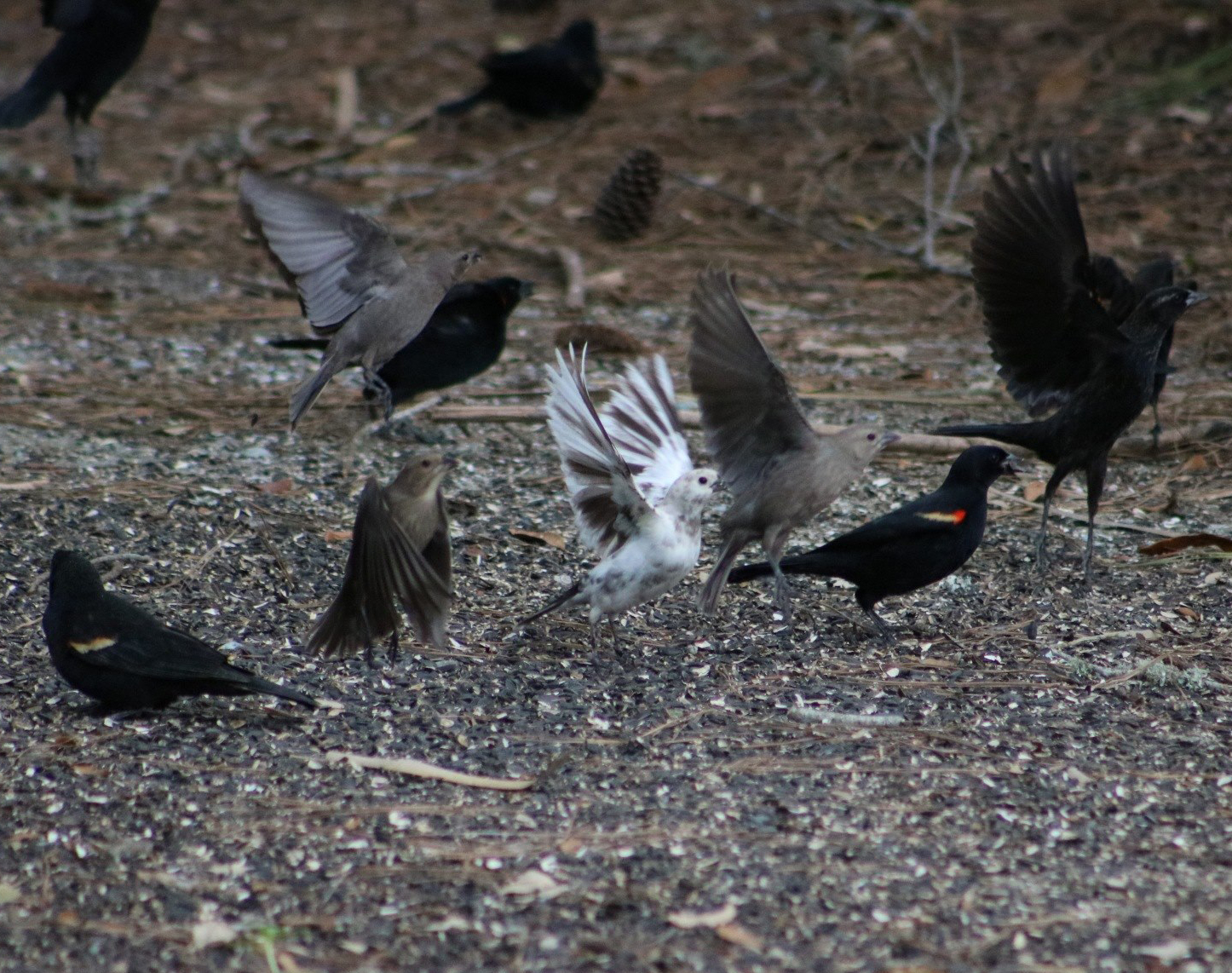
This past Thursday, Naturalists Jake Goodrum and Bradley Schmoll observed a pair of unusual white birds in a flock of red-winged blackbirds, cowbirds, and house finches. As if it had been blanketed by snow, the first bird noted was completely white. The second bird was mostly white with a few streaks of dark brown. Both birds were identified as leucisitc brown-headed cowbirds. One may think that these birds are albino – animals that do not produce melanin – however, the eyes of a true albino animal will be red or pink and both birds had dark-colored eyes. Animals with leucism can produce melanin, but they have a difficult time depositing the pigment in specific areas, hence the white feathers instead of the usual dark colorization of cowbirds. It was a neat discovery seeing these uniquely colored common birds visiting our feeders at Mingo Point. To learn more about which birds call Kiawah home, join us on any of our daily birding tours!
January 12, 2020 ~ Large Gulls in the Water
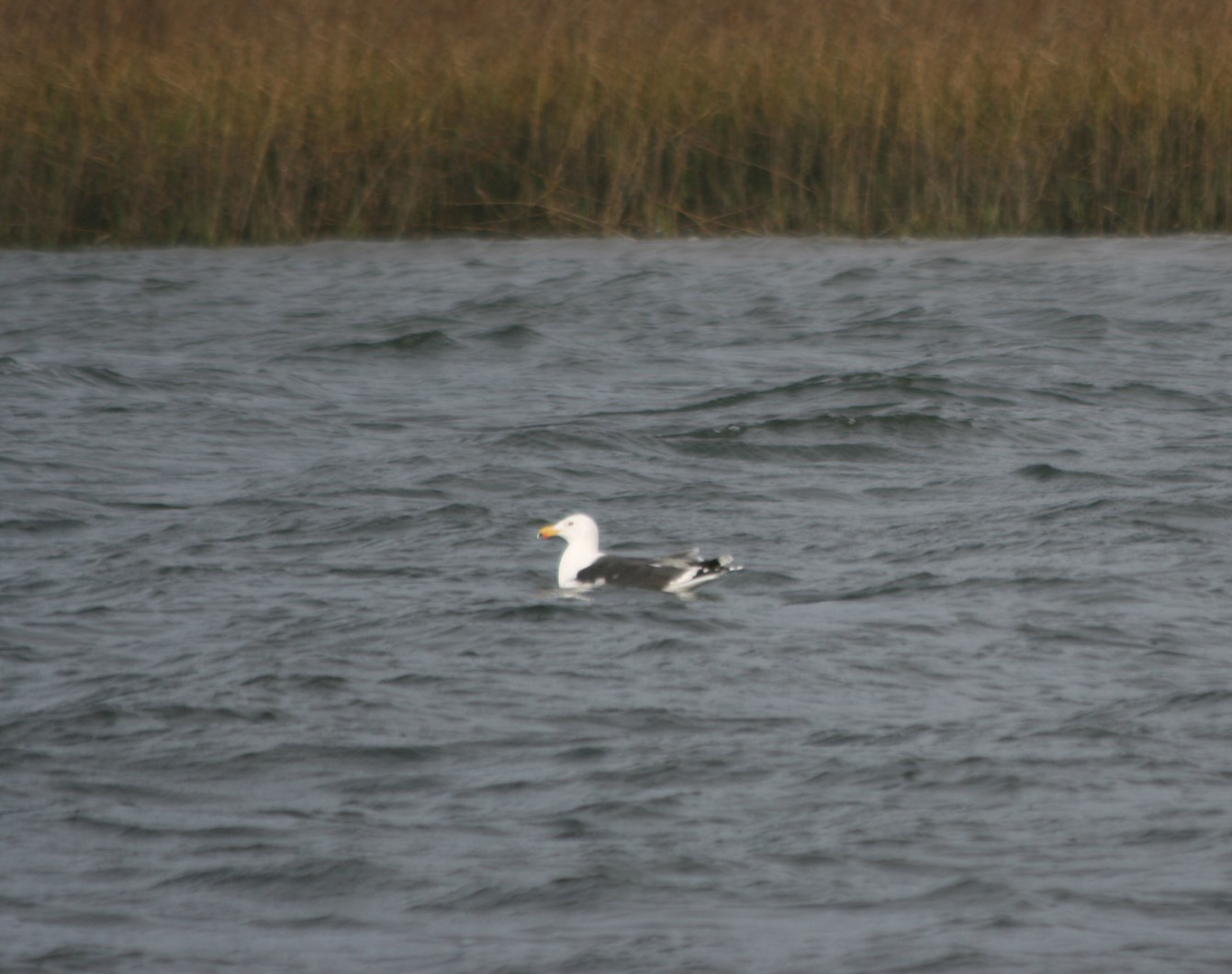
As the largest gull species in the world, the Great Black-backed Gull can be found along the eastern coast of North America. Their population can stretch from as far north as Newfoundland and south to Florida during the non-breeding season. They are easily distinguished from other gull and shorebird species, as they typically tower over them, possessing a wing span of up to 5.7 feet, and have a distinct appearance: white head, yellow bill, and dark black wings and back. These birds hunt a wide variety of food from invertebrates (mussels, crabs, sea urchins, etc.) to vertebrates (fish and other bird species), and will even feed on dead fish, or resort to stealing food from other animals. Our Naturalists were lucky to spot a Great Black-backed Gull while participating in the Christmas Bird Count on the Kiawah River. The gull was following a crabber around alongside a squadron of Brown Pelicans, as the crabber checked and baited his pots. Spotting this bird was a first for many of us, and we were all very excited as it was the largest gull any of us had ever seen!
January 10, 2020 ~ Winter = Sparrow Season
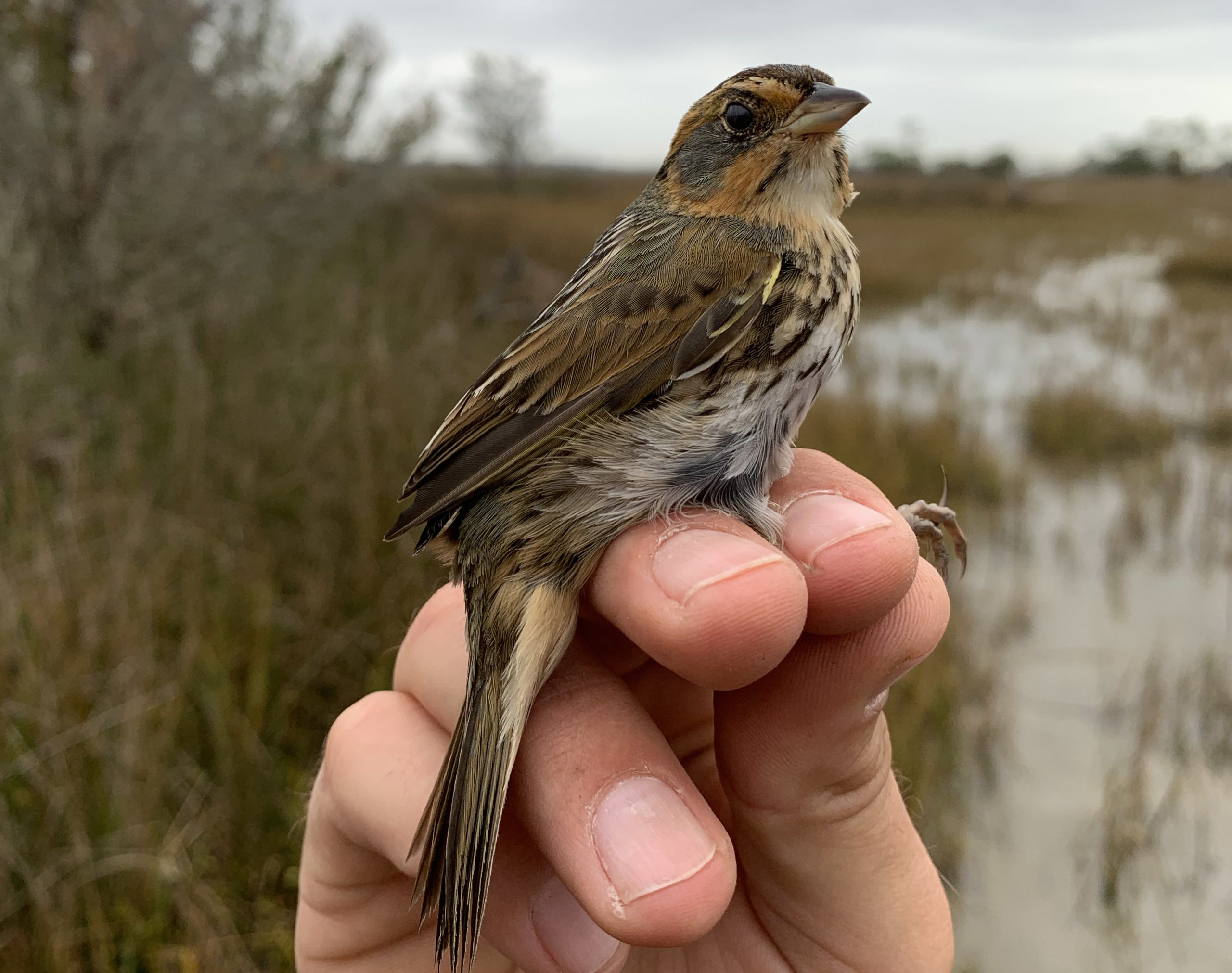
Many birds opt to move south as temperatures drop and food becomes scarce in the north. Some fly as far south as the southern tip of South America. Others are content spending the mild winters right here on Kiawah Island.
The bird in the picture is extra special winter resident to Kiawah Island. It is a Salt Marsh Sparrow and as their name suggests, they are found in the vast marshes on the backside of Kiawah Island. For the last several years Biologist from the town of Kiawah have waded out in to these marshes to capture and band these birds (along with a couple other unique sparrows) to better understand them. After provided a unique banding code they are released with the hopes they will be captured again in the future. This ongoing study has shown that many of these individual birds return to Kiawah year after year… And not only that, but they have a tendency to return to pretty much the same area they were captured at in previous years! Really neat stuff demonstrating how important healthy marshes to some fascinating animals.
January 05, 2020 ~ Why did the turkey cross the road?

If you’ve spent any time on Kiawah between November and now, you probably spotted the two Wild Turkeys that have been roaming the western half of the island. We often spot them foraging along the Kiawah Island Parkway, scratching through the leaf litter looking for nuts, seeds, or berries to snack on and sometimes invertebrates like snails or beetles. It is not uncommon to come across Wild Turkeys in this area, in fact this species can be found in 49 of our 50 states, Mexico and even into Canada! If you are coming to visit Kiawah in the coming months, make sure to drive slowly and keep an eye out for these two beautiful birds and you may be able to catch a glimpse of their iridescent feathers.
– Naturalist AK